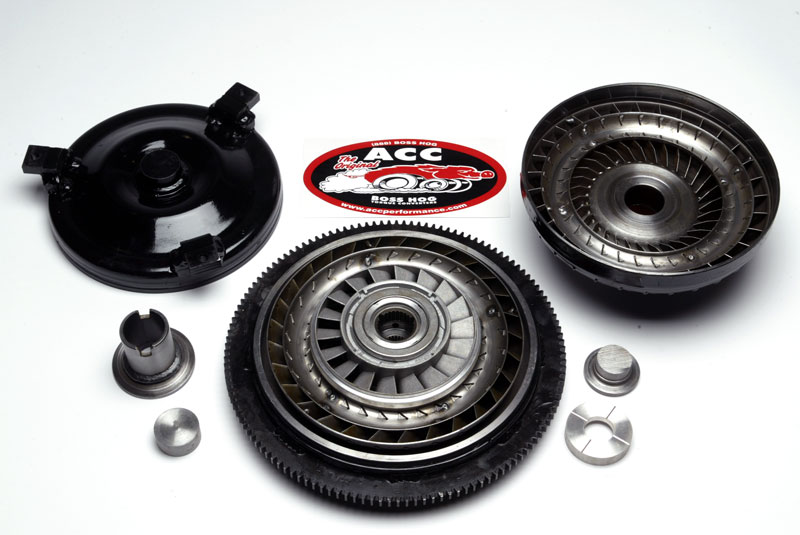In Part 1 of our All About Stall series, we shared three factors to consider when choosing torque converter stall speed range: engine setup, vehicle weight, and rear gear.
When considering engine setup, the tech experts at Summit Racing suggest using the camshaft powerband as a starting point for choosing stall range. However, there are many variables, and the torque converter guys at ACC Performance/Boss Hog have outlined how the slightest modification to the complete engine setup can require a change in stall range (see Part 1 for more details).
But how do major engine components affect stall speed?
According to Nelson Gill, President and CEO of ACC Performance, airflow in and out of the engine has a direct effect on choosing the ideal torque converter size and stall speed for an application. We need to know how the cylinder heads breathe and how much backpressure is generated by the exhaust system configuration.
Let’s start with the cylinder heads.
Cast iron heads, which are common on older vehicles, are very dense and hold in a great deal of heat. Aluminum heads, on the other hand, will dissipate heat faster and generate more power due to lower temperatures.
Once we choose our head material, it’s time to get detailed. You will need to know the combustion chamber size of the head in order to find out how fast the fuel is burning. Valve size also has a lot to do with how a four-stroke engine works. For example, a larger intake valve allows for a larger air-fuel intake charge, leading to a greater response to combustion. With a larger intake valve, you also need a larger exhaust valve to exhaust the spent gases. Smaller valves, by contrast, may increase resistance to how the engine breaths. If there is more resistance, then a higher stall is required. Less resistance lowers the stall. Large-diameter torque converters will be affected by this more than smaller-diameter ones.
Once we know the breathing characteristics of the cylinder heads, we can follow the airflow path to the exhaust system. Exhaust backpressure has a direct effect on stall in the torque converter, and the type and size of the exhaust system will contribute to the amount of backpressure produced.
“Remember, the torque converter works off of fluid pressure versus resistance, and we’re ultimately trying to find the resistance that is preventing the vehicle from moving,” Gill said. “With less resistance, the torque converter will lock up at a lower rpm, because it will overcome the resistance against it more quickly.”
Case Study
To illustrate the point, ACC Performance/Boss Hog uses an engine setup with aluminum heads and 2.02-inch intake and 1.60-inch exhaust valves. The heads have 64cc combustion chambers that burn fuel quickly. The engine is attached to a set of 1 5/8-inch headers with a 2.50-inch collector pipe. The rest of the exhaust includes 2.50-inch exhaust pipes, dual chamber mufflers, and a crossover pipe, also known as an “H-pipe” exhaust system. This exhaust system will go all the way back to the rear bumper. With these parameters, there is less backpressure on the motor at low rpm and it will need to increase rpm to apply the backpressure needed to help overcome that resistance.
To understand the complexity of this calculation, consider the numerous types of exhaust systems which can affect the outcome:
1. Factory manifolds, Y pipe to a single pipe, single muffler, back to duals & out the back of the vehicle. This configuration will have the most backpressure.
2. Factory manifolds, true dual exhaust, two mufflers, out the back. This is the second-most restrictive system.
3. Headers, true dual exhaust, two mufflers, X-pipe configuration, then out the back is the third-most restrictive system.
4. Headers, true dual exhaust, two mufflers, H-pipe or cross-over pipe, then out the back is the fourth-most restrictive system.
5. Headers, true dual exhaust, two mufflers, then out the back is the fifth-most restrictive exhaust system.
6. Headers, no pipe or open headers is the least restrictive of these systems.
Special Note: With a 2.50-inch collector and a .500-inch lift cam that peaks at 6,500 rpm, it will take nearly 5,000 rpm to get the proper back pressure with open headers. This means that if you put an exhaust system on this application you could see more low-end torque and be faster.
Knowing the above allows you to figure out that stall range is variable. More complete information about the vehicle is needed to find the ideal stall range, but clearly cylinder head design and exhaust system configuration are key parts of the equation.
As mentioned earlier, your engine’s camshaft is another major factor in torque converter selection.
We’ll cover that in our next installment.


There are several of these posts that are very insightful and make since. Theses guys really know their stuff
Very good read, but ultimately didn’t answer anything. Your case study was pretty much my exact set up and I was waiting to hear what stall speed he actually used. I read all the way to the end and nothing……
I’m using a 3000 stall speed, by the way.
[…] Our initial All About Stall post established the significance of engine setup in choosing torque converter stall. Nelson Gill, President and CEO of ACC Performance, then demonstrated how variables in engine setup — things like cylinder heads and exhaust choice — can change your ideal stall speed in Part 2 of the series. […]
The most important factors are rear gear ratio and tire diameter. If the vehicle will be used on the street or the dragstrip. The horsepower and torque peaks.